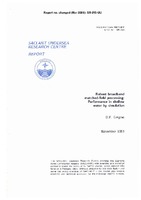| dc.contributor.author | Gingras, Donald F. | |
| dc.date.accessioned | 2018-10-11T14:06:49Z | |
| dc.date.available | 2018-10-11T14:06:49Z | |
| dc.date.issued | 1993/11 | |
| dc.identifier | 1995 | |
| dc.identifier.govdoc | SR-215 | |
| dc.identifier.uri | http://hdl.handle.net/20.500.12489/301 | |
| dc.description.abstract | An issue of concern for matched-field processing is the strong dependence between performance and | |
| dc.description.abstract | precise knowledge about the environmental parameters. Recently a robust matched-field processor | |
| dc.description.abstract | based on minimax robust filtering methods was developed. In this report simulation methods are | |
| dc.description.abstract | employed to evaluate the performance of the minimax robust method as well as other robust methods | |
| dc.description.abstract | for a range-independent shallow-water environment. The performance of the robust methods is | |
| dc.description.abstract | compared with that of the nominal processor, that is, the processor based on a single set of environmental parameters thought to be closest to the actual. The matched-field processing performance is evaluated in terms of the peak-to-sidelobe ratio, the simulation results indicate that the robust methods provide significant performance improvements over the nominal processor in the presence of uncertainty in water-column sound-speed, channel depth and sound speed in the bottom. | |
| dc.format | 29 p. : ill. ; 18 fig. | |
| dc.language | English | |
| dc.publisher | NATO. SACLANTCEN | |
| dc.relation.ispartofseries | ADB185601 | |
| dc.subject | Shallow water | |
| dc.subject | Signal processing | |
| dc.subject | Acoustic models | |
| dc.title | Robust broadband matched-field processing: performance in shallow water by simulation | |
| dc.type | Scientific Report (SR) | |
